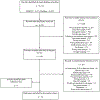Prescription opioid misuse among adolescents and emerging adults in the United States: A scoping review
- PMID: 31904397
- PMCID: PMC7024638
- DOI: 10.1016/j.ypmed.2019.105972
Prescription opioid misuse among adolescents and emerging adults in the United States: A scoping review
Abstract
The U.S. opioid epidemic is a critical public health problem. As substance use and misuse typically begin in adolescence and emerging adulthood, there is a critical need for prevention efforts for this key developmental period to disrupt opioid misuse trajectories, reducing morbidity and mortality [e.g., overdose, development of opioid use disorders (OUD)]. This article describes the current state of research focusing on prescription opioid misuse (POM) among adolescents and emerging adults (A/EAs) in the U.S. Given the rapidly changing nature of the opioid epidemic, we applied PRISMA Scoping Review (PRISMA-ScR) guidelines to identify empirical articles published in the past 5 years (January 2013-September 2018) from nine databases examining POM among A/EAs (ages 10-25) in the U.S. Seventy-six articles met our inclusion criteria focusing on POM in the following areas: cross-sectional surveys (n = 60), longitudinal cohort studies (n = 5), objective, non-self-reported data sources (n = 9), and interventions (n = 2). Final charted data elements were organized by methodology and sample, with results tables describing design, sample, interventions (where applicable), outcomes, and limitations. Most studies focused on the epidemiology of POM and risk/protective factors, including demographic (e.g., sex, race), individual (e.g., substance use, mental health), and social (e.g., peer substance use) factors. Despite annual national surveys conducted, longitudinal studies examining markers of initiation and escalation of prescription opioid misuse (e.g., repeated overdoses, time to misuse) are lacking. Importantly, few evidence-based prevention or early intervention programs were identified. Future research should examine longitudinal trajectories of POM, as well as adaptation and implementation of promising prevention approaches.
Keywords: Adolescents; Emerging adults; Opioid abuse; Opioid misuse; Prescription opioids; Scoping review.
Copyright © 2020 The Authors. Published by Elsevier Inc. All rights reserved.
Figures
References
-
- Centers for Disease Control and Prevention. Wide-ranging online data for epidemiologic research (WONDER). Atlanta, GA: 2017. [cited 2019 May 2], Available from: https://wonder.cdc.gov/.
-
- Kolodny A, Courtwright DR, Hwang CS, Kreiner P, Eadie JL, Clark TW, et al. The prescription opioid and heroin crisis: a public health approach to an epidemic of addiction. Annu Rev Public Health. 2015;36(559-74). - PubMed
-
- Rudd RA, Aleshire N, Zibbell JE, Gladden RM. Increases in Drug and Opioid Overdose Deaths – United States, 2000-2014. Morbidity and Mortality Weekly Report. 2016;64(50):1378–82. - PubMed
-
- Gomes T, Tadrous M, Mamdani MM, Paterson JM, Juurlink DN. The Burden of Opioid-Related Mortality in the United StatesThe Burden of Opioid-Related Mortality in the United States, 2001-2016The Burden of Opioid-Related Mortality in the United States, 2001-2016. JAMA Network Open. 2018; 1 (2):e180217–e. - PMC - PubMed
Publication types
MeSH terms
Substances
Grants and funding
LinkOut - more resources
Full Text Sources
Medical
Research Materials
Miscellaneous


